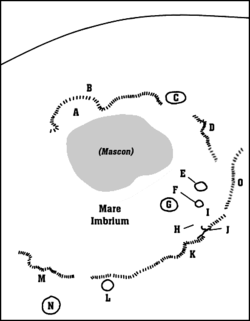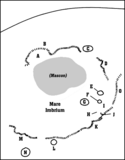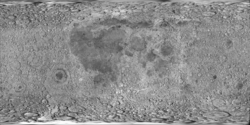Archimedes (kráter)
| Kráter Archimedes | |
|---|---|
 Archimedes | |
| Souřadnice na Měsíci | |
| Selenografická šířka | 29,7° S [1] |
| Selenografická délka | 4,0° Z [1] |
| Další údaje | |
| Typ kráteru | komplexní kráter |
| Průměr kráteru | 81 km [1] |
| Hloubka | 2,1 km |
| Colongitudo | 4° |
| Eponym | Archimédés |
Archimedes je rozsáhlý impaktní kráter na Měsíci pojmenovaný po řeckém matematikovi, fyzikovi, vynálezci a astronomovi Archimédovi. Leží na východní straně Mare Imbrium (Moře dešťů) a má průměr 81 km.[1] Východně od něj leží kráter Autolycus (průměr 39 km) a severovýchodně kráter Aristillus (průměr 54 km). Jižně leží pohoří Montes Archimedes pojmenované podle kráteru, na jeho severozápadním okraji nedaleko Archimeda leží kráter Bancroft.
Východně od kráteru Archimedes (poblíž kráteru Autolycus) dopadla 13. září 1959 sovětská sonda Luna 2, první člověkem vyrobené těleso na Měsíci.[2]
Satelitní krátery


V okolí kráteru se nachází několik menších kráterů. Ty byly označeny podle zavedených zvyklostí jménem hlavního kráteru a velkým písmenem abecedy.
| Archimedes | Sel. šířka | Sel. délka | Průměr |
|---|---|---|---|
| C | 31.6° S | 1.5° Z | 8 km |
| D | 32.2° S | 2.6° Z | 5 km |
| E | 25.0° S | 7.2° Z | 3 km |
| G | 29.1° S | 8.2° Z | 3 km |
| H | 23.9° S | 7.0° Z | 4 km |
| L | 25.0° S | 2.6° Z | 4 km |
| M | 26.1° S | 3.2° Z | 3 km |
| N | 24.1° S | 3.9° Z | 3 km |
| P | 25.9° S | 2.5° Z | 3 km |
| Q | 28.5° S | 2.4° Z | 3 km |
| R | 26.0° S | 6.6° Z | 4 km |
| S | 29.5° S | 2.7° Z | 3 km |
| T | 30.3° S | 5.0° Z | 3 km |
| U | 32.8° S | 1.9° Z | 3 km |
| V | 32.9° S | 4.0° Z | 3 km |
| W | 23.8° S | 6.2° Z | 4 km |
| X | 31.0° S | 8.0° Z | 2 km |
| Y | 29.9° S | 9.5° Z | 2 km |
| Z | 26.8° S | 1.4° Z | 2 km |
Následující krátery byly přejmenovány Mezinárodní astronomickou unií:
Kráter Archimedes v kultuře
- Kráter Archimedes je zmíněn ve vědeckofantastickém románu britského spisovatele Arthura C. Clarka Měsíční prach.[5]
Odkazy
Reference
- ↑ a b c d Crater Archimedes on Moon Gazetteer of Planetary Nomenclature, IAU, USGS (anglicky)
- ↑ RÜKL, Antonín. Atlas Měsíce. Praha: Aventinum, 1991. ISBN 80-85277-10-7. Kapitola Aristillus, s. 50/12.
- ↑ a b RÜKL, Antonín. Atlas Měsíce. Praha: Aventinum, 1991. ISBN 80-85277-10-7. Kapitola Timocharis, s. 68/21.
- ↑ RÜKL, Antonín. Atlas Měsíce. Praha: Aventinum, 1991. ISBN 80-85277-10-7. Kapitola Conon, s. 70/22.
- ↑ CLARKE, Arthur Charles. Měsíční prach. Praha: Odeon, 1989. Kapitola třetí, s. 23.
Externí odkazy
 Obrázky, zvuky či videa k tématu Archimedes na Wikimedia Commons
Obrázky, zvuky či videa k tématu Archimedes na Wikimedia Commons - (česky) Kráter Archimedes na www.obloha.webzdarma.cz
- LAC 41, mapa 1:1 000 000 (Lambertova projekce)
Média použitá na této stránce
Autor: Srbauer, Licence: CC BY-SA 3.0
A map of Mare Imbrium.
- A: Sinus Iridum (Regenbogenbucht)
- B: Montes Jura (Jura-Gebirge)
- C: Plato
- D: Montes Alpes (Alpen)
- E: Aristillus
- F: Autolycus
- G: Archimedes
- H: Palus Putretinis (Sumpf der Fäulnis)
- I: Hadley Rille
- J: Apollo 15 landing site
- K: Montes Apenninus (Apenninen)
- L: Erathostenes
- M: Montes Carpatus (Karpaten)
- N: Copernicus
- O: Montes Caucasus (Kaukasus)
cylindrical map projection of the Moon. The Moon's whole surface was mapped by the Clementine spacecraft in 1994, here North is at the top. The dark floor of crater Plato is at the middle top above Mare Imbrium, while the bright floor and rays of crater Tycho is near the middle bottom below Mare Imbrium. Mare Procellarum is at the near left, and Mare Tranquillitatis is just right of centre and Mare Crisium is at the near right. The far left and far right show the contrast of the mostly cratered farside with small isolated mare.
This is a view from the Apollo 15 looking northward. The large, flooded crater at center is Archimedes. To the south of the crater is the rugged terrain of the Montes Archimedes. The round crater near the left edge is Bancroft. Just visible to the upper right is part of Aristillus crater. The small range at top center is Montes Spitzbergen. The nearly flat plains along the left side are part of Mare Imbrium, while those to the east of Montes Spitzbergen are named Sinus Lunicus. This image was taken during the Apollo 15 mapping metric sequence, revolution 35. The original selenographic coordinates of the frame were 28.5° N, 3.5° W. The picture was produced by rotating the image 90° counter-clockwise so that north is toward the top edge, reducing it in size by 2/3, then cropping the blurred instrument covering the right edge.
Autor: M. Gålfalk, G. Olofsson, and H.-G. Florén; SIRCA camera, Licence: CC BY-SA 3.0
The Archimedes crater of the Moon and other features.
Archimedes is the largest crater near the center of the picture. It lies within the Mare Imbrium. The other large craters are Aristillus (to the right of Archimedes and higher, with pronounced central peak) and Autolycus (to the right and lower). At the lower right edge of the picture parts of the Montes Apenninus are visible.
Infrared image in L band centred on 3.75 micrometres. Taken with the SIRCA camera by M. Gålfalk, G. Olofsson, and H.-G. Florén. Nordic Optical Telescope, Stockholm Observatory. More images can be found here



